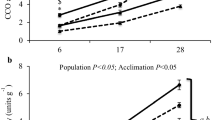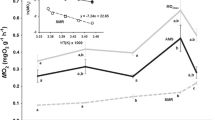Abstract
Cold-acclimation of rainbow trout brings only limited changes in muscle metabolic capacities, but marked modifications in membrane composition. Thus, we examined whether the functional properties of mitochondria from trout red muscle were modified by seasonal temperature acclimatization. Mitochondria from fall-acclimatized trout had higher maximal capacities (state 3 rates) for the oxidation of pyruvate and acyl carnitines at 12 and 20 °C than mitochondria isolated from summer-acclimatized trout. For these substrates, the increased oxidative capacity completely compensated for the seasonal drop in temperature. Pyruvate and palmitoyl carnitine were consistently the preferred substrates, while decanoyl and octanoyl carnitine were oxidized at higher rates than glutamine, particularly in fall trout. State 4 rates of oxygen uptake (obtained when all ADP has been converted to ATP) differed less among substrates, but varied seasonally. State 4 rates at 12 and 20 °C were higher in mitochondria isolated from fall than summer trout. At low temperatures, the Q10 of both maximal and state 4 rates of substrate oxidation tended to be higher for mitochondria from fall trout. The apparent Arrhenius activation energy (Ea) for mitochondrial pyruvate oxidation was higher in fall than summer trout whereas the Ea’s for palmitoyl carnitine and decanoyl carnitine oxidation did not change. The fatty acids of mitochondrial phospholipids from fall trout were more polyunsaturated than those from summer trout, with 12% more double bonds occurring than in summer trout, suggesting that membrane restructuring may be involved in the observed compensatory responses.
Similar content being viewed by others
References cited
Ball, D. and Johnston, I.A. 1996. Molecular mechanisms underlying the plasticity of muscle contractile properties with temperature acclimation in the marine fish Myoxocephalus scor-pius. J. Exp. Biol. 199: 1363–1373.
Ballantyne, J.S., Flannigan, D. and White, T.B. 1989. Effects of temperature on the oxidation of fatty acids, acyl carnitines and ketone bodies by mitochondria isolated from the liver of the lake charr, Salvelinus namaycush. Can. J. Fish. Aquat. Sci. 46: 950–954.
Ballantyne, J.S., Chamberlin, M.E. and Singer, T.D. 1992. Oxidative metabolism in thermogenic tissues of the swordfish and mako shark. J. Exp. Zool. 261: 110–114.
Beddow, T.A. and Johnston I.A. 1995. Plasticity of muscle contractile properties following temperature acclimation in the marine fish Myoxocephalus scorpius. J. Exp. Biol. 198: 193–201.
Beddow, T.A., Van Leeuwen, J.L. and Johnston, I.A. 1995. Swimming kinematics of fast starts are altered by temperature acclimation in the marine fish Myoxocephalus scorpius. J. Exp. Biol. 198: 203–208.
Bell, M.V., Henderson, R.J. and Sargent, J.R. 1986. The role of polyunsaturated fatty acids in fish. Comp. Biochem. Physiol. 83B: 711–717.
Blier, P.U. and Guderley, H. 1988. Metabolic responses to cold acclimation in the swimming musculature of lake whitefish, Coregonus clupeaformis. J. Exp. Zool. 246: 244–252.
Brand, M.D., Chien, L.-F., Ainscow, E.K., Rolfe, D.F.S. and Porter, R.K. 1994b. The causes and functions of mitochondrial proton leak. Biochim. Biophys. Acta. 1187: 132–139.
Brand, M.D., Couture, P. and Hulbert, A.J. 1994a. Liposomes from mammalian liver mitochondria are more polyunsaturated and leakier to protons than those from reptiles. Comp. Biochem. Physiol. 108B: 181–188.
Brett, J. R. 1967. Swimming performance of sockeye salmon in relation to fatigue time and temperature. J. Fish. Res. Bd. Can. 24: 1731–1741.
Chamberlin, M.E., Glemet, H.C. and Ballantyne, J.S. 1991. Glutamine metabolism in a holostean (Amia calva) and teleost fish (Salvelinus namaycush). Am. J. Physiol. 260 (Reg. Integ. Comp. Physiol. 29): R159–R166.
Crockford, T. and Johnston. I.A. 1990. Temperature acclimation and the expression of contractile protein isoforms in the skeletal muscles of the common carp (Cyprinus carpio L.). J. Comp. Physiol. B 160: 23–30.
Dean, J.M. 1969. The metabolism of tissues of thermally acclimated trout (Salmo gairdneri). Comp. Biochem. Physiol. 29: 185–196.
Egginton, S. and Sidell, B.D. 1989. Thermal acclimation induces adaptive changes in subcellular structure of fish skeletal muscle. Am. J. Physiol. 256(Reg., Integ. Comp. Physiol. 25): R1–R9.
Farkas, T., Csengeri, I., Majoros, F. and Olah, J. 1980. Metabolism of fatty acids in fish III. Combined effect of environmental temperature and diet on formation and deposition of fatty acids in the carp, Cyprinus carpio Linnaeus 1758. Aquaculture 20: 29–40.
Fry, F.E.J. and Hart, J.S. 1948. Cruising speed of goldfish in relation to water temperature. J. Fish. Res. Bd. Can. 7: 169–175.
Griffiths, J.S. and Alderdice, D.F. 1972. Effects of acclimation and acute temperature experience on the swimming speed of juvenile coho salmon. J. Fish. Res. Bd. Can. 29: 251–264.
Guderley, H. and Gawlicka, A. 1992. Qualitative modification of muscle metabolic organization with thermal acclimation of rainbow trout, Oncorhynchus mykiss. Fish Physiol. Biochem. 10: 123–132.
Guderley, H. and Johnston, I.A. 1996. Plasticity of fish muscle mitochondria with thermal acclimation. J. Exp. Biol. 199: 1311–1317.
Hazel, J.R. and Williams, E.E. 1990. The role of alterations in membrane lipid composition in enabling physiological adaptation of organisms to their physical environment. Progr. Lipid Res. 29: 167–227.
Hulbert, A.J. and Else, P.L. 1989. Evolution of mammalian endothermic metabolism: mitochondrial activity and changes in cellular composition. Am. J. Physiol. 256 (Reg., Integ. Comp. Physiol. 10): R63–R69.
Jenski L.J., Sturdevant, L.K., Ehringer, W.D. and Stillwell, W. 1991. ω3 fatty acids increase spontaneous release of cytosolic components from tumor cells. Lipids 26: 353–358.
Johnson T.P. and Bennett A.F. 1995. The thermal acclimation of burst escape performance in fish: an integrated study of molecular and cellular physiology and organismal performance. J. Exp. Biol. 198: 2165–2175.
Johnson, T.P., Bennett, A.F. and McLister, J.D. 1996 Thermal dependence and acclimation of fast start locomotion and its physiological basis in rainbow trout (Oncorhynchus mykiss). Physiol. Zool. 69: 276–292.
Johnston, I.A. and Maitland, B. 1980. Temperature acclimation in crucian carp (Carassius carassius L.): morphometric analysis of muscle fibre ultrastructure. J. Fish Biol. 17:113–125.
Johnston, I.A., Sidell, B.D. and Driedzic, W.R. 1985. Force-velocity characteristics and metabolism of carp muscle fibres following temperature acclimation. J. Exp. Biol. 119: 239–249.
Johnston, I.A., Guderley, H.E., Franklin, C.E., Crockford, T. and Kamunde, C. 1994. Are mitochondria subject to evolutionary temperature adaptation? J. Exp. Biol. 195: 293–306.
Johnston, I.A., Van Leeuwen, J.L., Davies, M.L.F. and Beddow, T. 1995. How fish power predation fast-starts. J. Exp. Biol. 198: 1851–1861.
Knipprath, W.G. and Mead, J.F. 1968. The effect of the environmental temperature on the fatty acid composition and on the in vivo incorporation of 1-14C-acetate in goldfish (Carassius auratus L.). Lipids 3: 121–128.
McCauley, R.W., Elliott, J.R. and Read, L.A.A. 1977. Influence of acclimation temperature upon preferred temperature in the rainbow trout (Salmo gairdneri). Trans. Am. Fish. Soc. 106: 362–365.
Miranda, E.J. and Hazel, J.R. 1996. Temperature-induced changes in the transbilayer distribution of phosphatidyl-ethanolamine in mitoplasts of rainbow trout (Oncorhynchus mykiss) liver. J. Exp. Zool. 274: 23–32.
Moyes, C.D., Buck, L.T., Hochachka, P.W. and Suarez, R.K. 1989. Oxidative properties of carp red and white muscle. J. exp. Biol. 143: 321–331.
Moyes, C.D., Buck, L.T. and Hochachka, P.W. 1990. Mitochondrial and peroxisomal fatty acid oxidation in elasmo-branchs. Am. J. Physiol. 258 (Reg. Integ. Comp. Physiol. 27): R756–R762.
Moyes, C.D., Mathieu-Costello, O.A., Brill, R.W. and Hochachka, P.W. 1992. Mitochondrial metabolism of cardiac and skeletal muscles from a fast (Katsuwonus pelamis) and a slow (Cyprinus carpio) fish. Can. J. Zool. 70:1246–1253.
Scherrer, B. 1984. Biostatistique. Gaëtan Morin Editeur, Chicoutimi, P.Q. Canada.
Sidell, B.D. 1980. Responses of goldfish (Carassius auratus L.) muscle to acclimation temperature: alterations in biochemis-try and proportions of different fiber types. Physiol. Zool. 53: 98–107.
Spector, A.A., John, K. and Fletcher, J.E. 1969. Binding of long-chain fatty acids to bovine serum albumin. J. Lipid Res. 10: 56–67.
Stillwell, W., Ehringer, W. and Jenski, L.J. 1993 Docosahexanoic acid increases permeability of lipid vesicles and tumour cells. Lipids 28: 103–108.
Taylor, S.E., Egginton, S., and Taylor, E.W. 1996. Seasonal temperature acclimatisation of rainbow trout: cardiovascular and morphometric influences on maximal sustainable exercise level. J. Exp. Biol. 199: 835–845.
Thibault, M., Blier, P.U. and Guderley, H. 1997. Seasonal variation of muscle metabolic organization in rainbow trout (On-corhynchus mykiss). Fish Physiol. Biochem. 16: 139–155.
Tyler, S. and Sidell, B.A. 1984. Changes in mitochondrial distribution and diffusion distances in muscle of goldfish upon acclimation to warm and cold temperatures. J. Exp. Zool. 232: 1–9.
Van Den Thillart, G. and Modderkolk, J. 1978. The effect of temperature on state III respiration and on the unsaturation of membrane lipids of goldfish mitochondria. Biochim. Biophys. Acta 510: 38–51.
Williams, E.E. and Hazel, J.R. 1995. Restructuring of plasma membrane phopholipids in isolated hepatocytes of rainbow trout during brief in vitro cold exposure. J. Comp. Physiol. B 164: 600–608.
Wodtke, E. 1981a. Temperature adaptation of biological membranes. The effects of acclimation temperature on the unsaturation of the main neutral and charged phospholipids in mitochondrial membranes of the carp (Cyprinus carpio). Biochim. Biophys. Acta 640: 698–709.
Wodtke, E. 1981b Temperature adaptation of biological membranes. Compensation of the molar activity of cytochrome c oxidase in the mitochondrial energy-transducing membrane during thermal acclimation of the carp (Cyprinus carpio L.). Biochim. Biophys. Acta 640: 710–720.
Author information
Authors and Affiliations
Rights and permissions
About this article
Cite this article
Guderley, H., Pierre, J.S., Couture, P. et al. Plasticity of the properties of mitochondria from rainbow trout red muscle with seasonal acclimatization. Fish Physiology and Biochemistry 16, 531–541 (1997). https://doi.org/10.1023/A:1007708826437
Issue Date:
DOI: https://doi.org/10.1023/A:1007708826437




